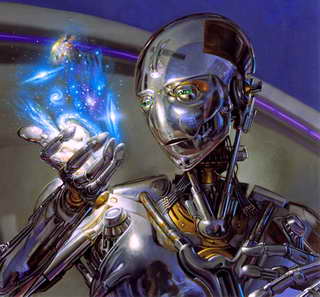Artificial Intelligence

The Basics
Computers that can think and react are no longer just something you come across in science fiction. They are
now a reality and can be seen doing everything from taking messages to assisting in surgery.
As humans, we like to think of ourselves as intelligent beings; as having the ability to acquire knowledge, apply that knowledge, and adapt that knowledge to our particular experiences and situations. A simplistic example of this is learning to cook. We absorb knowledge by reading a recipe, watching others cook the recipe, and perhaps even taking a class to learn how to cook that recipe. Then when we actually try that recipe, we may find it needs more salt. So the next time we cook that recipe, we adjust it. Thus we adapt our knowledge through our experience.
Artificial intelligence is no different, however, instead of humans, it is the capability of a
man-made device, such as a computer, robot or toy, to think it ways that we as humans think.
Artificial intelligence in a machine is much more than just the input of data, it also involves the machine
being able to apply that data, reason with that information, and to learn and grow through experience.
Computers have surpassed the input of just bytes and bits and spitting out punch cards and reams of paper.
Todays computers have gone far beyond just keyboard entry; they can also respond to voice commands and visual signals.
The field of Artificial Intelligence includes the actual science and engineering of making intelligent machines,
especially intelligent computer programs. In addition, artificial intelligence can be looked at as the study of machines
and man-made systems which can be programmed to act in a manner that mimics human intelligence.
Artificial intelligence, which is also referred to as AI, implies that machines will be able to mimic that human
behavior of learning through experience; such as learning that a recipe needs more salt. Science fiction novels and movies often portray
computers and robots as machines that are indeed capable of acquiring intelligence and even surpassing the capabilities of the human mind.
AI is advancing on many fronts. There are a number of sub-disciplines that contribute to the science and technology of creating
machines that are capable of artificial intelligence. These areas include:
Natural Language Processing
Robotics
Neural Networks
Game Playing
Expert Systems
But there are many individuals who do not believe that a machine with a reasoning, artistic, changing and adaptable mind
can ever be created. Researchers in the field of artificial intelligence make the assumption that human intelligence and
reasoning, in its most basic form, can be reduced to a set of symbols, such as 0s and 1s. Manipulating these symbols
is then a form of intelligence. Philosophers argue that although computers may do tasks that require intelligence,
such as solving complex mathematical problems, computers can only appear to be intelligence. Computers are merely
simulating intelligent behavior. One philosopher, John Searle, says that the idea of a non-biological machine being intelligent
is simply incoherent.
Today AI research is working to produce machines that can automate a multitude of human tasks that traditionally required
what we would call human intelligence to complete. Some of the current tasks that being passed on to machines include:
military uses including scheduling, robotic soldiers and self flying planes;customer relationship software that can answer
customers questions on products; understanding and transcribing speech (a very beneficial task for individuals with disabilities);
motorized robotic vacuums and lawnmowers, robotic doctors and nurses, and even cars that can adjust the heating, air conditioning
and radio stations through the owners voice commands.
^ Top ^


